Abhijit Mitra , Anagh Pal , Kavya Balaji , Pheji Phalghunan, Outlook Money
You cannot choose your boss, they say. While true in most situations, it doesn't mean you cannot boot the boss out of your life. Many a smart, hard-working subordinate knows that the only way to maximise their financial valuation is by working for themselves, not anyone else. Only a handful of them, however, have been able to transform thought into action. There are two main reasons for this. The first is risk. Economists distinguish between salaries and profits. The first is the remuneration for labour. The second is for risk borne by an entrepreneur. However fat a salary someone may draw, the profits, the real big money, will always go to the person he works for - his boss and the bearer of the risk.
How 5 employees became successful employers
Image: No happy-go-lucky entrepreneur.In this, the first story of our new section, Enterprise, we spoke with five entrepreneurs who had dumped the 'boss'. Their businesses are as diverse, both in scope and sector, as their location and backgrounds.
What is common, apart from their risk-taking ability and passion, is that their businesses have broken even. Here are the stories of how they did it. (We hope it will be your 1 per cent solution too.)
How 5 employees became successful employers
Image: Nitin Gupta (R), Rohan Gupta.Little did Nitin Gupta, 32, and Rohan Gupta, 30, know that a trip to New Delhi's Nehru Place computer market in early 2007 would change the course of their lives.
From Dehradun, Nitin was then working for Lotus Interworks in the US after doing his MBA from the Stern School of Business at New York University. Brother Rohan, a chemical engineer by training, was working in Bangalore. Nitin had brought Rohan a laptop, so the two went out to sell the old one. While they waited, they asked the shopowner what he did with old machines. City of location: New DelhiDate of launch: February 2008
Initial startup capital: $6.3 million (about Rs 26 crore)
External funding if any: Draper Fisher Jurvetson, NEA-Indo US Ventures
Date of break-even: Quarter ended September 2010
Performance indicator: Processes 3,600 tonnes of e-waste per annum
Turnover: $1 million (about Rs 4.5 crore) in 2009-10
How 5 employees became successful employers
Image: Attero makes e-waste eco-friendly.
How 5 employees became successful employers
Image: Solving the e-waste problem.
How 5 employees became successful employers
Image: 130 million mobiles sold every year.
How 5 employees became successful employers
Image: Processing tonnes of e-waste.That apart, there are smelters that makes billets and an electrolysis unit that uses a patent pending technology to extract non-ferrous metals, both precious and non-precious, of 99.99 per cent purity.
These are sold on the MCX and provide the company about 90 per cent of its revenue currently. The rest comes from companies (there are 185 on the client list now), some of which pay a fee to Attero to dispose of their e-waste. The problem, though, is elsewhere. "Even large corporates do not care about the way their e-waste is disposed of," says Nitin, adding, "it takes a lot of convincing to make them give their scrapped computers and peripherals to us."He is hoping that changes in law and increased awareness will help the business grow. As of now, the plant is processing 3,600 tonnes of e-waste a year.
How 5 employees became successful employers
Image: Nitin Gupta.But true to their entrepreneurial spirit, Nitin and Rohan are on the lookout for more revenue streams. Non-cyclable plastics is one. The research team is trying out a pyrolysis process to extract carbon black and furnace oil from it -there's good demand for both.
They are also researching related gadgets. That apart, usable parts of computers are being separated and assembled into PCs that are sold for about Rs 4,000 a piece to those who cannot afford new ones, with a takeback and recycle guarantee. In 2010, two more rounds of funding, from Granite Hill Capital Partners and International Finance Corporation brought it another $8.3 million (about Rs 37 crore). Every time the Guptas find the gold, the rest of the world can hope for a rainbow above it.
How 5 employees became successful employers
Image: Anant Kumar.The glass door to his rather airy, un-air-conditioned and sparsely furnished office on the top floor of a brightly painted, but humble-looking building in downtown Secunderabad does not have an engraved nameplate.
Instead, you find stuck on it an A4 sized printout with the letters 'An' followed by the picture of an ant. Makes you wonder if it relates to the industrious little creature. Then, the answer to the on-your-face rebus dawns on you. 'An-ant' Kumar, founding CEO of Life Spring Hospitals - an expanding chain of hospitals providing high-quality, low-cost maternity care to low-income women - is not your typical honcho.He walks to his nearby home occasionally for lunch, often climbs up the stairs to his fifth-floor office, stopping by to wave to the nurses, or speak to happy new moms.
City of location: HyderabadDate of launch: 1st hospital launched in December 2005
Initial startup capital: Rs 7.5 crore
External funding if any: Startup capital provided by Hindustan Latex. Raised the next Rs 7.5 crore from Acumen Fund in 2007
Date of break-even: 1st hospital broke even in an year
Performance indicator: 9 hospitals
How 5 employees became successful employers
Image: Life Spring Hospital.
How 5 employees became successful employers
Image: A big social impact.
How 5 employees became successful employers
Image: Life Spring makes mothers happy.How 5 employees became successful employers
Image: Life Spring Hospital.
How 5 employees became successful employers
Image: Life Spring Hospital.A few rooms away, the conference room, named after Vanaja, the first mother to give birth at the Moula Ali hospital, showcases the different awards Life Spring has received.
As we take a look, a faint but piercing cry of a newborn wafts through from one of the floors below. There could, perhaps, be no better award for Kumar and his team.
How 5 employees became successful employers
Image: Pratyaksh Bhagi (R) and Ajay Yadav.After what seemed like a never-ending search in the alleys of Goregaon, there couldn't have been a more welcoming drink than the chilled Jaljeera straight from the kitchen of Diet Delivery, a diet meal service in Mumbai.
Started in 2009 by young entrepreneurs Pratyaksh Bhagi and Ajay Yadav, both in their late 20s, Diet Delivery promises to keep your calorie count under check. For a city bustling with outsider majority, a place to order quality, low on oil, nutrition rich meal is indeed a blessing.City of location: Mumbai
Date of launch: May 2009
Initial startup capital: Rs 3 lakh (Rs 1.5 lakh each)
External funding if any later raised: Rs 10 lakh from friends
Date of break-even: September 2010
Performance indicator: Caters 750 meals a day
Turnover/profit: Rs 1.3 crore/Rs 35 lakh in 2010
How 5 employees became successful employers
Image: Diet Delivery's supply chain."Everyone is confident about their own idea, but there is always struggle," says Bhagi, who left his job as a banker with Kotak Mahindra Bank after a two-and-a-half-year stint, for his passion for business. Yadav, whose family runs a restaurant in Mumbai, had also thought of doing something on a moderate scale, but on his own.
Recession had set in and the restaurant was not doing well. Moreover, with three brothers and a single restaurant, it was better to move out.Bhagi and Yadav, friends since 1999, started their journey with an investment of Rs 1.5 lakh each. "Most of the money went into R&D," says Yadav.
At first, they gave meals for free sampling. With the help of friends, they prepared a questionnaire and, based on the responses, finalised the pricing and other decisions.
How 5 employees became successful employers
Image: Diet Delivery for healthy food.The initial targets were call centre employees. "They are a young crowd and would rather spend their money on partying or something flashier," explains Bhagi.
Next, they targeted corporates. They decided to sell the idea of 'good food for employees' to the HR departments of companies. Who knew that convincing them would be tougher than convincing the CEOs?
How 5 employees became successful employers
Image: A healthy food service.There wasn't any encouragement from parents though. If the Yadavs thought that there was no need for their son to become a dabbawalah, then Bhagi's parents had had their share of hardships during their unsuccessful experiment of running a cinema theatre.
How 5 employees became successful employers
Image: A success story.2011 has started on a bright note. They have already received an offer from Etisalat to start a franchise in Dubai. More offers from other cities are coming in. "By March, we are expecting a turnover of Rs 1.3 crore," says Bhagi, hastily adding that it's not much. But looking back from where they started, they have arrived.
How 5 employees became successful employers
Image: Mallika Shanker.Vivacious, passionate, determined...adjectives are just not enough to describe Mallika, the founder and co-owner of Samms Juke Box.
A mother of two kids, she looks surprisingly young and is all giggly like a teenager. Only when you talk to her can you see the fire in her eyes and the passion in her voice.Mallika is confidence personified when asked how she runs her business. She has all her clients' information at her fingertips. It is unbelievable that this 37-year-old, who speaks fluent English and Hindi, is not a graduate. But that has never stopped this go-getter from achieving what she desired.
City of location: ChennaiDate of launch: 2001
Initial startup capital: Rs 25,000
External funding if any: None
Date of break-even: 2002
Performance indicator: Tie-ups with more than 5,000 petrol pumps in India
Turnover: Rs 1 crore in 2009
Profit:Rs 15 lakh in 2009
How 5 employees became successful employers
Image: Samms Juke Box campaign.
How 5 employees became successful employers
Image: HPCL.Her hard work at HPCL paid off. Mallika got a call from Bharat Petroleum for a Rs 27-lakh campaign that involved cross-promotions at BPCL outlets. Their journey had started. Today, they have tie-ups with HPCL, BPCL and Indian Oil for cross-promotions.
How 5 employees became successful employers
Image: Emarat petroleum.How 5 employees became successful employers
Image: Incredible India campaign.She says education is not the only criterion for becoming a successful entrepreneur: "No amount of research can prepare you for the uncertainties of a business." Evidently, this clear-headed and passionate woman is ready to take uncertainty in her stride!
How 5 employees became successful employers
Image: Ajit Andhare.Ajit Andhare, founder and CEO of Colosceum Media, a content and production company, wouldn't have ever imagined his life would revolve around soaps.
Be it a 12-year spell with Hindustan Unilever (HUL), or the path he chose to tread on his own later.In the middle of a busy street in Andheri, Mumbai, Colosceum's office is abuzz with Andhare and his core team of 25 whipping up new ideas to keep modern India glued to their television sets.
Name your shows and chances are that there's at least one produced by Colosceum-Splitsvilla, MasterChef India, MTV Roadies, Jai Sri Krishna, Bhandhan and Jamunia, to name a few.
City of location: Mumbai
Date of launch: November 2007
Initial startup capital: Rs 4 crore
External funding if any: PE Funding from Media Venture Capital Trust
Date of break-even: March 2008-09
Performance indicator: Producers of shows like Splitsvilla, Smart Shrimati, MasterChef India, Roadies 8 and many others.
Profit: About Rs 40 crore (Rs 400 million) in 2010
How 5 employees became successful employers
Image: Ajit Andhare.Andhare put together his brainchild, Colosceum, in 2007 after moving on with his first-and last-employer HUL. A bright engineering student from National Institute of Technology, Rourkela, who dreamt of building dams and bridges, Andhare was stumped when the consumer products manufacturing giant offered a placement. "I didn't want my entire career to be washed down by a bar of soap," recollects Andhare, smilingly.
How 5 employees became successful employers
Image: Top team: Ajit Andhare, Rajiv Lakshman, Nivedita Basu, Lalit Sharma ( L to R)
How 5 employees became successful employers
Image: Advertisement for Tata Indicom.
How 5 employees became successful employers
Image: Colosceum bets big on media.
How 5 employees became successful employers
Image: Jai Shri Krishna won many awards."We are already big in reality. We have plans to explore new media, 3G, and so on. Media is a small industry, you need to innovate constantly," he says of his plans to make Colosceum a multi-genre production house.
For a guy who detested soaps, could Andhare's journey be described as coincidence, just like everything else in his life?




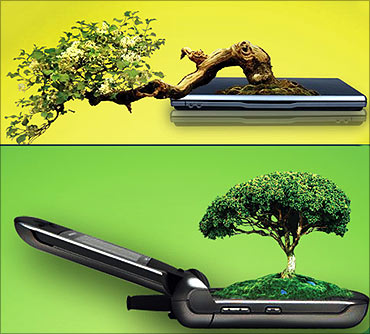


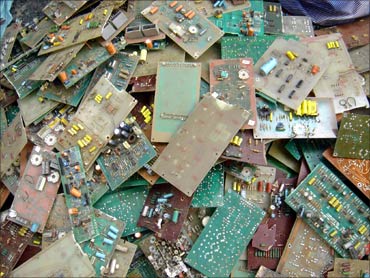
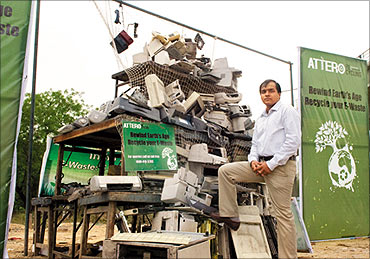
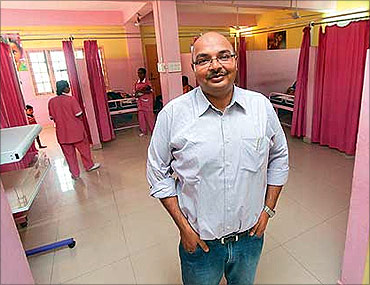

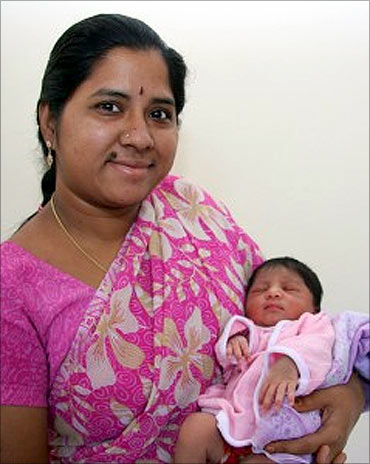

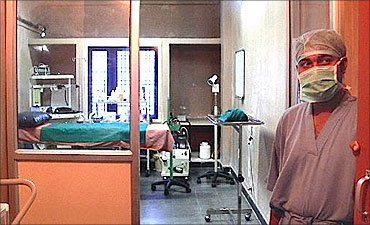
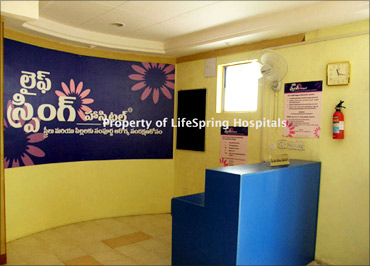





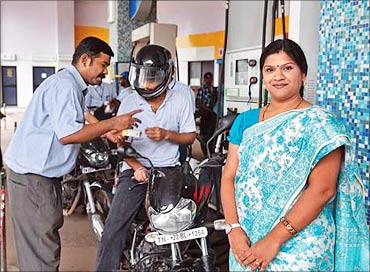
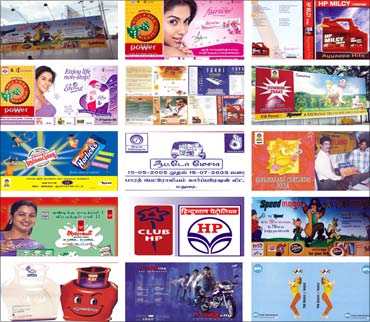

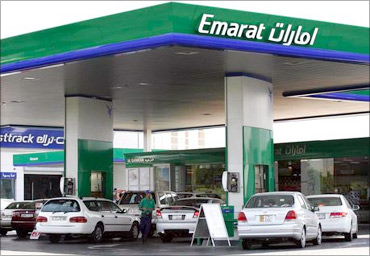








article